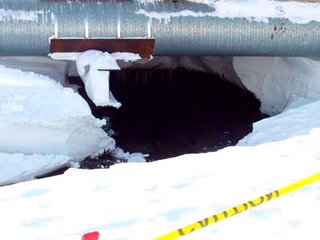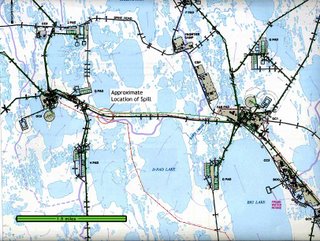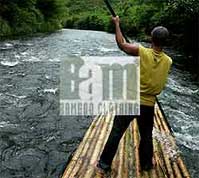Oil pipeline leak in Alaska, update
>
In its second week, the Alaskan pipeline oil spill caused by a failure of a pencil size section in a 34" diameter oil pipeline is well on its way to being cleaned up say BP Oil authorities. The leak, which went undiscovered for several days, dumped as much as a quarter of a million gallons of low grade crude oil onto the frozen roadway near "Big Lake" in Alaska's north shore pipeline terminal about 650 miles north of Anchorage. The area is in the Prudhoe Bay region 40 miles west of Alaska's wilderness range, the largest of all U.S. land preserve areas.
Satellite photos of spill site.
Because of severe winter conditions, as much as forty degrees below zero, workers did not discover the leak until it was spotted by a maintenance worker during a routine survey. Unified Command has released detailed information including aerial photos and land topographic overlays of the disaster site as well as details of the response team's plan for clean up and restoration. Critics of the Alaskan pipe line system and its operators BP Petroleum were quick to monitor the condition of the spill, and continue to criticize some officials for not maintaining a satisfactory inspection system for the 1100 miles of pipeline. They further insist that such spills, while infrequent, will increase as the system ages. They say that with an estimated 12 to 20 years of production remaining, the pipelines will fail at a faster rate in the future, increasing the damage to this sensitive area, beyond its ability to recover.
 Even BP executives say that it is likely that the small area, a little more than 84,000 square feet (about 2 acres), will ever fully recover. Cold weather and permafrost tundra conditions likely helped to mitigate the damage they say. Frozen earth does not as easily absorb the viscous oil. At the same time, fresh fallen snow concealed the spill so more leakage occurred than would have during the summer months.
Even BP executives say that it is likely that the small area, a little more than 84,000 square feet (about 2 acres), will ever fully recover. Cold weather and permafrost tundra conditions likely helped to mitigate the damage they say. Frozen earth does not as easily absorb the viscous oil. At the same time, fresh fallen snow concealed the spill so more leakage occurred than would have during the summer months.
Environmentalists want better monitoring and more frequent inspections. Company officials said that their cost of prevention was increased 10 fold last year, to more than $3.5 million annually, when a similar leak resulting from a hunter firing his rifle into an elevated pipeline threatened a remote area of the tundra. Officials worried then, as now, that the aging system was breaking down more quickly than had been forecast.
by Harlan Weikle
Greener Magazine

In its second week, the Alaskan pipeline oil spill caused by a failure of a pencil size section in a 34" diameter oil pipeline is well on its way to being cleaned up say BP Oil authorities. The leak, which went undiscovered for several days, dumped as much as a quarter of a million gallons of low grade crude oil onto the frozen roadway near "Big Lake" in Alaska's north shore pipeline terminal about 650 miles north of Anchorage. The area is in the Prudhoe Bay region 40 miles west of Alaska's wilderness range, the largest of all U.S. land preserve areas.
Satellite photos of spill site.

Because of severe winter conditions, as much as forty degrees below zero, workers did not discover the leak until it was spotted by a maintenance worker during a routine survey. Unified Command has released detailed information including aerial photos and land topographic overlays of the disaster site as well as details of the response team's plan for clean up and restoration. Critics of the Alaskan pipe line system and its operators BP Petroleum were quick to monitor the condition of the spill, and continue to criticize some officials for not maintaining a satisfactory inspection system for the 1100 miles of pipeline. They further insist that such spills, while infrequent, will increase as the system ages. They say that with an estimated 12 to 20 years of production remaining, the pipelines will fail at a faster rate in the future, increasing the damage to this sensitive area, beyond its ability to recover.
 Even BP executives say that it is likely that the small area, a little more than 84,000 square feet (about 2 acres), will ever fully recover. Cold weather and permafrost tundra conditions likely helped to mitigate the damage they say. Frozen earth does not as easily absorb the viscous oil. At the same time, fresh fallen snow concealed the spill so more leakage occurred than would have during the summer months.
Even BP executives say that it is likely that the small area, a little more than 84,000 square feet (about 2 acres), will ever fully recover. Cold weather and permafrost tundra conditions likely helped to mitigate the damage they say. Frozen earth does not as easily absorb the viscous oil. At the same time, fresh fallen snow concealed the spill so more leakage occurred than would have during the summer months. Environmentalists want better monitoring and more frequent inspections. Company officials said that their cost of prevention was increased 10 fold last year, to more than $3.5 million annually, when a similar leak resulting from a hunter firing his rifle into an elevated pipeline threatened a remote area of the tundra. Officials worried then, as now, that the aging system was breaking down more quickly than had been forecast.
by Harlan Weikle
Greener Magazine



12:43 PM









<< Home